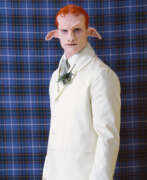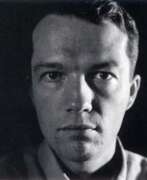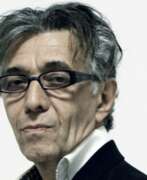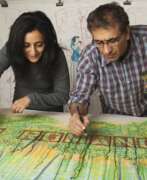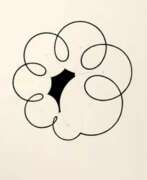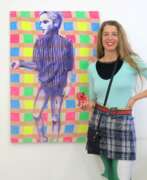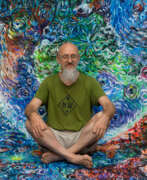Performance art Contemporary art


Marina Abramović is a Serbian conceptual and performance artist. Her work explores body art, endurance art, feminist art, the relationship between the performer and audience, the limits of the body, and the possibilities of the mind. Being active for over four decades, Abramović refers to herself as the "grandmother of performance art". She pioneered a new notion of identity by bringing in the participation of observers, focusing on "confronting pain, blood, and physical limits of the body". In 2007, she founded the Marina Abramović Institute (MAI), a non-profit foundation for performance art.


Vito Acconci was an American artist, designer, and architect. He is best known for his pioneering work in the field of performance art and for his provocative installations that explore the relationship between the human body and space.
Acconci received a Bachelor of Arts degree from Holy Cross College in 1962. He later earned a Master of Fine Arts degree from the University of Iowa.
In the late 1960s and early 1970s, Acconci became known for his groundbreaking performance works, which often involved the artist subjecting his own body to various forms of physical and psychological stress.
In the 1980s and 1990s, Acconci shifted his focus to installation art, creating immersive environments that challenged viewers' perceptions of space and their own bodies. He also worked as a designer and architect, creating public sculptures and buildings around the world.
Acconci's work has been exhibited in major museums and galleries worldwide, including the Museum of Modern Art in New York and the Venice Biennale. He received numerous awards and honors for his contributions to contemporary art, including the Skowhegan Medal for Sculpture in 1995.
His legacy as an influential and provocative artist continues to be felt in the contemporary art world today.


Terry Roger Adkins was an American artist. He was Professor of Fine Arts in the School of Design at the University of Pennsylvania.
Adkins was an interdisciplinary artist whose practice included sculpture, performance, video, and photography. His artworks were often inspired by, dedicated to, or referred to musicians or musical instruments; specific installations and exhibitions were sometimes labeled "recitals." Sometimes, these arrangements of sculptures were "activated" in performances by Adkins' collaborative performance group, the Lone Wolf Recital Corps.


Francis Alÿs is a Belgian-born, Mexico-based artist.
His work emerges in the interdisciplinary space of art, architecture, and social practice. In 1986, Alÿs left behind his profession as an architect and relocated to Mexico City.
He has created a diverse body of artwork and performance art that explores urban tensions and geopolitics. Employing a broad range of media, from painting to performance, his works examine the tension between politics and poetics, individual action and impotence.


Ghada Amer (Arabic غادة عامر) is a contemporary artist, much of her work deals with issues of gender and sexuality. Her most notable body of work involves highly layered embroidered paintings of women's bodies referencing pornographic imagery.
Amer had previously emigrated from Egypt to France at the age of 11 and was educated in Paris and Nice. She is currently living and working in New York City.


John Armleder is a Swiss performance artist, painter, sculptor, critic, and curator. His work is based on his involvement with Fluxus in the 1960s and 1970s, when he created performance art pieces, installations and collective art activities that were strongly influenced by John Cage. However, Armleder's position throughout his career has been to avoid associating his artistic practice with any type of manifesto.


Trisha Baga is an American artist working in various media, including video installations, sculpture, painting and audio installations. She is known for her experiments with technology and often uses voice and body in her work.
Her work is often interactive and a combination of different elements such as projections, sounds, objects and movement. She is also known for her use of private elements such as mobile phones to create unique and personal works of art.
Trisha Baga draws on the heritage of sculpture, painting, music, photography and literature in her practice. Among the subjects and themes she explores are contemporary events, the worship of heroes and celebrities, and collective history. Baga's installations often include film, consisting of montages and collages of found footage and photographs, stacked in such a way that some images obscure others; the films are projected directly onto the wall, over personal items and rubbish from her studio so that they cast shadows on the projection.
Her work has been exhibited in many museums and galleries around the world, including the Museum of Modern Art in Los Angeles, the Museum of Modern Art in New York and the Venice Biennale.


Frank Balve is a German conceptual artist.
He creates paintings, photographs, sculptures, performances and films, and his work is often inspired by literary works, from Dante to the Marquis de Sade. Balve designs his images with paint, builds them from stone or paper, stages them in front of the camera, and puts them into language. In special installations he combines his works to create spaces of experience for the viewer to work on.


Mary Hildegard Ruth Bauermeister was a German artist who worked in sculpture, drawing, installation, performance, and music. Influenced by Fluxus artists and Nouveau Réalisme, her work addresses esoteric issues of how information is transferable through society. Beginning in the 1970s, her work concentrated on the themes surrounding New Age spirituality, specifically geomancy, the divine interpretation of lines on the ground.


Kevin Beasley is an American artist working in sculpture, performance art, and sound installation. He lives and works in New York City. Beasley was included in the Whitney Museum of American Art's Biennial in 2014 and MoMA PS's Greater New York exhibition in 2015.


Vanessa Beecroft is an Italian-born American contemporary performance artist; she also works with photography, video art, sculpture, and painting. Many of her works have made use of professional models, sometimes in large numbers and sometimes naked or nearly so, to stage tableaux vivants. She works in the United States, and is based in Los Angeles as of 2009. Her early work was focused on gender and appeared to be autobiographical; her later work is focused on race. Starting in 2008 she began working with Kanye West on collaborations and commercial projects.


Mirella Bentivoglio is an Italian painter, sculptor and poet, representative of visual concrete poetry.
She was trained as an art historian and artist in Italy, Switzerland and England, and in the 1960s she joined the concrete poetry movement and began to use elements of the alphabet to create expressive images. A few years later, Bentivoglio became increasingly interested in sculpture, turning letters into three-dimensional forms. In many of her later works, two images, a book and an egg, began to recur.


Thomas Bernstein is a German visual artist and art teacher. From 1978 to 1985 he studied at the Düsseldorf Art Academy. In addition to figurative works on paper, the sculptor, draftsman and performer also creates anthropomorphic sculptures from various materials, primarily silicone. The dominant theme in his performances is movement, the everyday and the absurd. While his pictorial works relate to questions of human communication, he shows abstract body-related forms in his sculptures. These can be found in his figurative drawings in a more naturalistic way.


Wolfgang E. Biedermann / Wolfgang Erich Hessler, a German abstract painter and graphic artist, began his artistic journey under the guidance of Ursula Mattheuer-Neustädt. He studied at the Leipzig Academy of Visual Arts and worked as a freelance artist in Leipzig. Biedermann's artistic career spanned from 1960 to 2008, during which he developed his own technique, creating abstract paintings and paper works using various printing methods. He exhibited his artwork extensively in Germany and internationally. Biedermann also participated in happenings and performances with the artist group "Clara Mosch" and collaborated on experimental outdoor installations called "Pleinairs."


Jonathan Borofsky is an American artist known for his public sculptures and installations that explore themes of human consciousness, individuality, and interconnectedness.
Borofsky studied at Carnegie Mellon University and Yale University. In the 1970s, he gained recognition for his conceptual and performance works, which often incorporated elements of language, text, and repetition.
In the 1980s, Borofsky began creating large-scale public sculptures, many of which feature human figures or silhouettes. One of his most famous works is "Molecule Man," a 100-foot-tall sculpture of three interconnected figures located in Berlin, Germany.
Borofsky's work has been exhibited in major museums and galleries around the world, including the Museum of Modern Art in New York, the Centre Georges Pompidou in Paris, and the National Museum of Contemporary Art in Seoul. He has also created public artworks in cities such as New York, Tokyo, and Tel Aviv.
In addition to his art, Borofsky is known for his interest in meditation and spirituality, which he often incorporates into his work. He has published several books on these topics.
Borofsky continues to live and work in Ogunquit, Maine, where he maintains a studio and creates new works of art.


Mark Boyle is a Scottish media artist from the British underground.
Since 1985 he and his wife Joan Hills and their children Sebastian and Georgia formed a collaborative art group called The Boyle Family. The Boyle family experimented with different techniques and styles. This included performances and events, films and projections, sound recordings, photography, electronic micro-photography, drawing, assemblage, painting, sculpture and installation.
However, their most famous long-term project remains Journey to the Earth's Surface, which they began in 1964 and which is a continuum of strange and interesting works. These paintings-very precise drawn casts, something in between painting and sculpture-are careful recreations of randomly selected sections of the earth's surface using resin and fiberglass, as well as real materials collected from the site under investigation.


Kerstin Brätsch is a German contemporary visual artist who often creates large-scale, highly abstract works that combine multiple media. She studied at the University of Art in Berlin and Columbia University in New York and received a Master of Fine Arts degree in 2007. She currently lives and works in New York.
Brecht creates large works that she exhibits in a particular manner. This is as far as possible from the standard form of exhibiting artwork. She hangs her works on magnets, inserts them in double glass frames and rests them against the wall, leaving them on the floor. Using this peculiar method of presentation, she combines a bit of performance art into her visual works.
In 2014, Bratsch was awarded the August Macke Prize. In 2017, Bratsch was awarded the second Edvard Munch Art Prize, which is a cash prize and a solo exhibition at the Munch Museum in 2019.


Micha Brendel is a German artist living and working in Hohendorf/Lower Lusatia.
Brendel started his career as an assistant artist, then studied at the Kunsthochschule Berlin-Weißensee and at the HfBK Dresden. He was one of the founders of the Auto-Perforations-Artisten association and editor of independent magazines for artists.
Brendel's early works centered on self-portraits and photographs of his own body, distorted with photographic techniques. He also made extensive use of organics, including animal bones and skin, in the creation of a wide variety of works. A common theme is self-destruction and alienation, shock and disgust. Brendel wrote detailed accounts of his creative process that became the basis for books.
Brendel's work, which often crosses boundaries, includes drawings, photographs, inscriptions, artist's books, taxidermy objects, installations and performances. He is currently intensifying his work with writing and nature and curating exhibition projects.


Guillaume Bruère is a French painter, drawer, sculptor and performer. He lives and works in Berlin.
Guillaume Bruère graduated from the Ecole des Beaux-Arts de Nantes (DNSEP) in 1999, then from the Ecole Européenne Supérieure de l'Image in Poitiers in 2003.
Fascinated by the major artists of art history (Holbein, Dürer, Rembrandt, Goya, Van Gogh, Giacometti, Picasso, Bacon), Guillaume Bruère has been working since 2009 in many museums and prestigious institutions (e.g. Kunsthaus Zürich, Musée Picasso Paris, Fondation Vincent Van Gogh Arles) to reinterpret their works, notably through drawing.
From his confrontation with the art of the past (Egyptian, Greek, Mexican, heraldic art, etc.), a singular, dense universe of extraordinary vitality emerges through the use of colour, the expressiveness of his gesture, the sureness of his line, and collage, which can be found in many of his drawings, but also in his painting, sculpture and performances.


Tania Bruguera is an artist and activist who focuses on installation and performance art. She lives and works between New York City and Havana, and has participated in numerous international exhibitions. Her work is in the permanent collections of many institutions, including the Museum of Modern Art and Bronx Museum of the Arts and the Museo Nacional de Bellas Artes de La Habana.
Bruguera's work pivots around issues of power and control, and several of her works interrogate and re-present events in Cuban history. As a result of her artistic actions and activism, Bruguera has been arrested and jailed several times.


Lee Bul (Korean: 이불) is a South Korean contemporary visual, installation and performance artist. She is known for her provocative and thought-provoking works that explore themes such as identity, technology, and the human body.
Lee Bul studied sculpture at Hongik University in Seoul and received her MFA from the same institution in 1987. She emerged as a prominent artist in the 1990s and has since exhibited her works in major museums and galleries around the world.
One of her most well-known works is "Majestic Splendor," a large-scale installation created in 1991 that features a series of sculptural forms made from materials such as fiberglass, wire, and beads. The work is inspired by the utopian visions of modernist architecture and design, but also incorporates elements of decay and fragmentation.
In recent years, Lee Bul has continued to create works that challenge and engage her viewers. For example, her 2017 installation "Willing To Be Vulnerable" features a series of abstract sculptures made from materials such as crystal, metal, and leather, which are arranged in a labyrinthine structure that viewers can walk through. The work explores themes of power and vulnerability, and encourages viewers to reflect on their own relationships with these concepts.
Lee Bul's works have been exhibited at major institutions such as the Guggenheim Museum in New York, the Centre Pompidou in Paris, and the Museum of Modern Art in Tokyo. She has also received numerous awards and honors, including the 2001 UNESCO Prize for the Promotion of the Arts and the 2017 Ho-Am Prize in the Arts.


Fran Bull is an American sculptor, painter, and print-maker living and working in Brandon, Vermont and Barcelona, Spain. Bull became known originally for her Photorealism paintings made in the mid 1970s and 80s. In the late 1980s, Bull’s art began to develop towards abstraction, or neo-abstract expressionism. Sparked by her newfound approach to painting, in the mid-1990s Bull began to explore other media. Since that time her artistic output has included performance art, sculpture, mixed media, and printmaking, as well as painting. She has been especially prolific in the area of printmaking. Bull has produced many diverse series of etchings that continue to be exhibited worldwide.
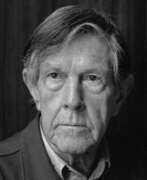

John Milton Cage Jr. is an American composer, philosopher, poet, musicologist, and artist. Cage is considered one of the leading figures of the post-war avant-garde.
Born in the United States, he studied architecture in Europe, but music and painting seemed more interesting to him and he has achieved impressive success there. John Cage is considered a pioneer of uncertainty in music and the unconventional use of instruments, and is highly regarded for his paintings and prints. In addition, he played a crucial role in the development of modern dance and performance art.
His father John Milton Cage (1886-1964) was an inventor.


Yoan Capote is a Cuban sculptor. He received the UNESCO prize during the 7th Havana Biennial with the artists' collective DUPP (Desde Una Pragmática Pedagógica).
Yoan Capote follows the line of many other internationally known artists, working at the same time with different medias and genres (painting, photography, performance sculptures and installations). One of his works entitled Open Mind 2006 is a labyrinth based on the drawing of the human brain where people can walk. People become metaphors for neurons transmitting information as they walk around the maze. This work inspires reflection on the interrelation among persons, who attempt to coexist with each other. Yoan Capote work can be found in many private collections around the world, and institutions such as the Kendall Art Center / The Rodriguez Collection, Miami, Florida.


Mario Ceroli is an Italian sculptor. His work has been exhibited at the Museum of Modern Art in New York City and the Mississippi Museum of Art in Jackson, Mississippi. One of his sculptures is on the Luigi Einaudi campus of the University of Turin, and another one is at the Vatican Museums.


Peter Coffin is an American artist. He is known for his conceptual and interdisciplinary works that explore the relationship between humans and the natural world.
Coffin's work often incorporates a range of media, including sculpture, painting, photography, video, and performance. He frequently engages with scientific and philosophical concepts, such as the nature of perception and the relationship between humans and animals.
Coffin's work has been exhibited in major museums and galleries around the world, including the Hirshhorn Museum and Sculpture Garden in Washington, D.C., the Whitney Museum of American Art in New York, and the Centre Pompidou in Paris.
He has received numerous awards and grants for his work, including a Guggenheim Fellowship in 2013. Coffin's work is noted for its ability to bridge the gap between art and science, and to encourage viewers to think critically about their place in the world.
Peter Coffin lives and works in London.


Matthew Darbyshire is a British artist. He is known for his multimedia works that explore contemporary consumer culture and the built environment.
Darbyshire often works in sculpture, installation, and photography, using materials such as concrete, metal, and plastic. His work often references the aesthetics of modernist architecture and design, and he frequently incorporates found objects and images from popular culture into his pieces.
In 2014 Darbyshire created the polystyrene sculpture Hercules, which is an imitation of the Farnese Hercules. The deliberate choice of a white material has been interpreted as a perpetuation of colourism in how we view and understand classical sculpture.
Darbyshire's work has been exhibited in major museums and galleries around the world, including the Tate Britain in London, the Museum of Modern Art in New York, and the Venice Biennale. In 2015, he was shortlisted for the Hepworth Prize for Sculpture.
His work is noted for its critical engagement with consumer culture and the built environment, as well as its use of humor and playfulness to explore complex social and cultural issues.


Ellen Kristina Abelli Elander is a Swedish artist, illustrator and sculptor.
She was educated at Birkagårdens folkhögskola and at the beginning of her artistic journey she was interested in the monstrous and the morbid, the grotesque and the cannibalistic. Later on the figure of the Alien appears and becomes central in Elander's works, participating in human life in one way or another.
The artist uses painting, drawing, textile sculpture and ceramics to express her ideas, creates spatial installations, and also draws comics.


Eva & Adele are an artistic couple who claim to have "landed their time machines" in Berlin after the Wall fell in 1989, claiming to be "hermaphrodite twins from the future". Both refuse to tell their real name or age. They are famous mainly for sharing an invented gender, which is neither male nor female.
They are also known for their performance art, they have been represented by an art gallery since 1997, as they make paintings, video art, photography and costume design. They also have their own perfume line and a watch with Swatch.
They have been recognized as the world's longest running performance art duo and are often photographed as fashion icons at art events, like Art Basel Miami Beach and the Venice Biennale.


Daniel Firman is a French visual artist and sculptor.
In his sculptures, Firman seeks to construct the presence of such amorphous concepts as time, balance, weight, action, and gravity.
Always focused on the body, Firman has also explored performance art — including choreographed works in which he constructs enclosures around himself — and crafted immersive, overwhelming sound installations of 'Drone Music.'
Firman's work is included in major collections worldwide. The artist lives and works in Bordeaux and New York.


Wolfgang Flatz is a contemporary Austrian artist, stage designer, musician and composer. Currently lives and works in Munich, Germany.
After engaging with contemporary art movements such as Heppening and Viennese Actionism, Flatz creates works using a variety of media - painting, sculpture, performance, video, computer, film, photography, theatre, music, design and architecture. Subjects include voyeurism, the body, violence, aggression, pain, love, politics and audience interaction.


Sylvie Fleury is a Swiss contemporary pop artist known for her installations, sculpture, and mixed media. Her work generally depicts objects with sentimental and aesthetic attachments in consumer culture, as well as the paradigm of the new age, with much of her work specifically addressing issues of gendered consumption and the fetishistic relationships to consumer objects and art history.


Alison Erika Forde is a British artist who often uses old, discarded objects, prints, household wood in her art. She transforms these unnecessary things into imaginary fragments of dreams and illusions. The artist creates vibrant multi-dimensional art that includes sculpture, paint, and performance art.


Giuseppe Fortunato is a versatile Italian artist, sculptor, designer, and draftsman. At the end of the 1980s he created, together with other artists, the Images movement. Fortunato's famous paintings were created in the technique of collage with enamel on canvas, and elements of surrealism and metaphysical painting can be traced in his work.


LaToya Ruby Frazier is an American visual artist, renowned for her profound work that delves into social justice, cultural change, and the American experience. Born in 1982 in Braddock, Pennsylvania, Frazier utilizes various media, including photography, video, and performance, to explore themes of industrialism, environmental justice, and human rights. Her art, deeply rooted in collaborative storytelling, often portrays her family and community, offering a lens into the lived experiences of working-class families amid societal and environmental challenges.
Her notable series "The Notion of Family" explores her family's life in Braddock, revealing the impacts of industrial decline on the community and environment. This work not only highlights LaToya Ruby Frazier's personal narrative but also serves as a broader commentary on race, class, and the American industrial landscape. Her commitment to social documentation is further exemplified in projects like "Flint is Family," where she immersed herself in Flint, Michigan, to document the water crisis's impact on local families.
LaToya Ruby Frazier's exhibitions span across prestigious venues in the US and Europe, reflecting her influence and recognition in the art world. Her works are part of esteemed collections like The Museum of Modern Art and the Whitney Museum of American Art in New York. Frazier's accolades include a MacArthur Fellowship, demonstrating her significant contributions to contemporary art and social activism.
For art collectors and experts, Frazier's work offers a compelling intersection of art, activism, and storytelling, providing insightful perspectives on pressing social issues through the lens of personal and community narratives.
To stay informed about LaToya Ruby Frazier's work and related updates, including new product sales and auction events, subscribing to updates is a valuable opportunity for enthusiasts and collectors alike to engage with her impactful artistry and advocacy.


Hamish Fulton is an English walking artist. Since 1972 he has only made works based on the experience of walks. He translates his walks into a variety of media, including photography, illustrations, and wall texts. His work is contained in major museums collections, such as the Tate Britain and MoMA. Since 1994 he has been creating group walks for the public. Fulton argues that 'walking is an artform in its own right' and argues for wider acknowledgement of walking art.


Aaron Garber-Maikovska is a contemporary artist. He is known for his multidisciplinary approach, which incorporates sculpture, performance, video, and installation art.
Garber-Maikovska's work often explores themes of power, violence, and the body. He has exhibited his work internationally, including at the Whitney Museum of American Art in New York, the Palais de Tokyo in Paris, and the Kunsthalle Basel in Switzerland.
Some of his notable works include "The Power and the Glory," a performance piece in which the artist dressed in a suit made of raw meat and recited a monologue about the nature of power, and "Shadow Boxing," a series of sculptures that depict fighters engaged in violent combat.
Garber-Maikovska is also a co-founder of the art collective Dear Reader, which explores the intersection of art and literature through exhibitions, readings, and other events.


Jochen Gerz is a German conceptual artist who lived in France from 1966 to 2007. His work involves the relationship between art and life, history and memory, and deals with concepts such as culture, society, public space, participation and public authorship. After beginning his career in the literary field, Gerz has in the meantime explored various artistic disciplines and diverse media. Whether he works with text, photography, video, artist books, installation, performance, or on public authorship pieces and processes, at the heart of Gerz's practice is the search for an art form that can contribute to the res publica and to democracy. Gerz lives in Sneem, County Kerry, Ireland, since 2007.


Douglas Gordon is a Scottish artist. He won the Turner Prize in 1996, the Premio 2000 at the 47th Venice Biennale in 1997 and the Hugo Boss Prize in 1998. He lives and works in Berlin, Germany.
Much of Gordon's work is seen as being about memory and uses repetition in various forms. He uses material from the public realm and also creates performance-based videos. His work often overturns traditional uses of video by playing with time elements and employing multiple monitors.


Todd Gray works in photography, performance and sculpture as a contemporary artist who lives and works in Los Angeles, California and Akwidaa, Ghana.
Writing in the catalogue for the exhibition Black is, Black Ain't at the Renaissance Society, Chicago, Amy M. Mooney writes "critics have noted that Gray's work is "fluent in cultural iconography, driven by introspection, and steeped in issues of corporate politics and racial identity" and that his self-portraits thwart a traditional read of the exterior likeness". Gray describes himself as an artist and activist who primarily focuses on issues of race, class, gender, and colonialism, and uses these lenses to challenge binaries in the past and present. In general, his work aims to challenge the viewer both by what he is including and what he is leaving out.


Doug Hall is an American photographer and media artist, who has received national and international recognition for his work in a range of practices including performance, installation, video, and large scale digital photography. He was a member of T. R. Uthco Collective (1970–1978). From 1981 to 2008, he was a member of faculty in the New Genres Department at the San Francisco Art Institute (SFAI). After retiring from the SFAI, he joined the Graduate Fine Arts faculty at the California College of the Arts (CCA) from 2008 to 2015.


Susan Hefuna is a German-Egyptian artist working in various fields of art.
She was born from the union of an Egyptian and a German, which put her at the intersection of the two cultures in which she was immersed. Hefuna completed her PhD in multimedia at the Institute for New Media in Frankfurt. She lives between Egypt and Germany and works in a variety of media including drawing, photography, sculpture, installation, video and performance. Hefuna combines her Egyptian and German roots in her work, using urban imagery, typography and traditions from both to build a bridge between the two cultures.
Hefuna's work often incorporates the form or image of the characteristic mashrabiya, an oriental carved wooden or stone architectural lattice screen.


Gottfried Helnwein is an Austrian-Irish visual artist. He has worked as a painter, draftsman, photographer, muralist, sculptor, installation and performance artist, using a wide variety of techniques and media.
His work is concerned primarily with psychological and sociological anxiety, historical issues and political topics. His subject matter is the human condition. The metaphor for his art is dominated by the image of the child, particularly the wounded child, scarred physically and emotionally from within. His works often reference taboo and controversial issues from recent history, especially the Nazi rule and the horror of the Holocaust. As a result, his work is often considered provocative and controversial.
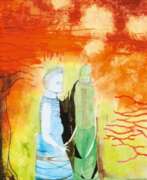

Lothar Hempel is a German media artist living and working in Berlin.
Lothar studied at the Academy of Fine Arts Düsseldorf and works in a wide range of media, combining the abstract and figurative in dramatic stage sets. Drawing from a variety of styles - Dadaism, Constructivism, the Bauhaus school - Hempel creates works in the fields of sculpture, drawing and painting, video, performance and installation. He utilizes visual metaphors, including images or found objects.
Lothar Hempel has been exhibiting regularly since 1991.
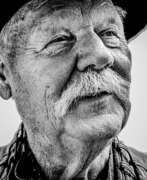



Karl Holmqvist is a Swedish artist known for his text based works, poetry and readings. Holmqvist has exhibited at the ICA — Institute of Contemporary Arts 2009, CAM — Chelsea Art Museum, 2009, The Living Art Museum, Reykjavik (2008), Tensta Konsthall (2008) Manifesta 7 — Comitato Manifesta 7, Bolzano (2008) and at PERFORMA 05 — Performa, New York City, NY (2005).


Rebecca Horn is a German visual artist, who is best known for her installation art, film directing, and her body modifications such as Einhorn (Unicorn), a body-suit with a very large horn projecting vertically from the headpiece. She directed the films Der Eintänzer (1978), La ferdinanda: Sonate für eine Medici-Villa (1982) and Buster's Bedroom (1990). Horn presently lives and works in Paris and Berlin.


Parker Ito is an American contemporary artist. He was raised in Long Beach, California and currently works in Los Angeles. Ito's art practice encompasses a wide range of media, including painting, sculpture, video, performance, and installation.
Ito is known for his exploration of the intersection of technology and contemporary art. He often incorporates digital elements into his work, such as using UV printing on canvas, digital painting, and 3D printing. Ito's work also frequently deals with issues of identity, representation, and the commodification of art.
Ito has exhibited his work in numerous solo and group exhibitions in galleries and museums around the world.


Zhu Jinshi is a Chinese artist and pioneer of Chinese abstract painting and installation. He paints colourful abstractions reminiscent of German Expressionism, with highly sculptural surfaces in thickly applied oil paint.
While in Europe, Zhu Jinshi began experimenting with performance, installation and conceptual art. The artist currently lives and works in Beijing.


Colette Justine, better known as Colette Lumiere, is a Tunisian-born, American multimedia artist known for her pioneering work in performance art, street art, and her use of photography to create photographic tableau vivant. She is also known for her work exploring male and female gender roles, use of guises and personas, and for soft fabric environments, where she often appears as the central element.


Anish Kapoor is a British-Indian sculptor specializing in installation art and conceptual art.
Kapoor became known in the 1980s for his geometric or biomorphic sculptures using simple materials such as granite, limestone, marble, pigment and plaster. These early sculptures are frequently simple, curved forms, usually monochromatic and brightly coloured, using powder pigment to define and permeate the form.
Since 1995, he has worked with the highly reflective surface of polished stainless steel. These works are mirror-like, reflecting or distorting the viewer and surroundings. Over the course of the following decade Kapoor's sculptures ventured into more ambitious manipulations of form and space.


Michael Kelley was an American artist. His work involved found objects, textile banners, drawings, assemblage, collage, performance and video. He often worked collaboratively and had produced projects with artists Paul McCarthy, Tony Oursler, and John Miller. Writing in The New York Times, in 2012, Holland Cotter described the artist as "one of the most influential American artists of the past quarter century and a pungent commentator on American class, popular culture and youthful rebellion."


Terence Koh is a Canadian artist. He is known for his provocative and often controversial works that explore themes of spirituality, sexuality, and identity.
Koh works in a variety of media, including sculpture, performance, and installation. He often incorporates found objects and materials into his pieces, such as bones, hair, and glitter.
One of his most well-known works is "Gone, Yet Still," a performance piece in which the artist covered himself in white paint and stood motionless in a gallery for hours at a time. The work explored ideas of stillness, mortality, and transcendence.
Koh's work has been exhibited in major museums and galleries around the world, including the Whitney Museum of American Art in New York, the Museum of Contemporary Art in Los Angeles, and the Tate Modern in London.
He has been the recipient of numerous awards and grants, including the Louis Comfort Tiffany Foundation Award in 2007. His work is noted for its confrontational and often unsettling qualities, as well as its ability to challenge viewers' assumptions and beliefs about art and the world around them.


Eva Kot'átková is a Czech installation artist and filmmaker living and working in Prague.
Eva studied at the Prague Academy of Fine Arts, the Prague Academy of Applied Arts, the San Francisco Art Institute and the Vienna Academy of Art. The artist's work combines sculpture, text and performance. Her installations usually consist of multiple objects, drawings, photographs, models, and sometimes videos. Her aim is to show how much our personal lives are influenced by our social environment. In her ongoing series "Theater of Talking Objects", Eva Kot'átková tries to find alternative ways of self-expression for those who cannot communicate and integrate in a standard way.
She is co-founder of the Anxiety Institute platform, which examines anxiety as a result of social, political, economic and environmental forces.


Elad Lassry is an Israeli-American artist who lives and works in Los Angeles.
Lassry defines his practice as consumed with "pictures" — generic images culled from vintage picture magazines and film archives, redeploying them in a variety of media, including photography, film, drawing and sculpture. Leaving little distance between the commercial and the analytical, he is sometimes described as a post-Pictures Generation artist.
Starting with popular modes of production such as magazine advertising, he uses silk-screening and photography to revive iconic art-historical arrangements, such as the pairing of mother and child or the arrangement of fruit a conventional still life, disrupting their original harmony with geometric displacements or a palette of bright colours. His chromogenic color prints — still life compositions, photocollages, and studio portraits of friends and celebrities — never exceed the dimensions of a magazine page or spread (35 x 28 cm) and are displayed in frames that derive their colors from the dominant hues in the photographs.


Chris Levine is a British photographic artist known for his interdisciplinary approach to photography.
Chris Levine is an artist of light who works with various mediums in search of an expanded state of perception and awareness through image and form. Levin's practice across multiple projects is distinguished by the cross-fertilization of many creative fields, including music, performance, installation, fashion and design.
He became widely known when he created the sensational portrait of Her Majesty Queen Elizabeth II, based on light and stillness, a completely new image of the most famous woman in the world.


Volker Via Lewandowsky is a German artist who works with installation, sculpture, object art, photography, performance, painting and drawing.
Via Lewandowsky works in diverse artistic media. He is most familiar for his sculptural-installation works and exhibition scenographies with architectonic influences.
His preference for tragicomedy, absurdity and paradox as well as the Sisyphean drama of continuous repetition and futility of action link Via Lewandowsky's art with Dadaism, Surrealism and Fluxus.






















